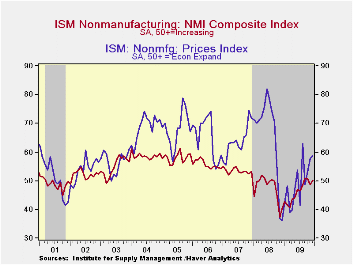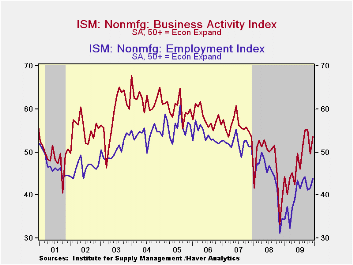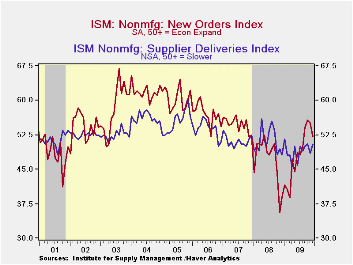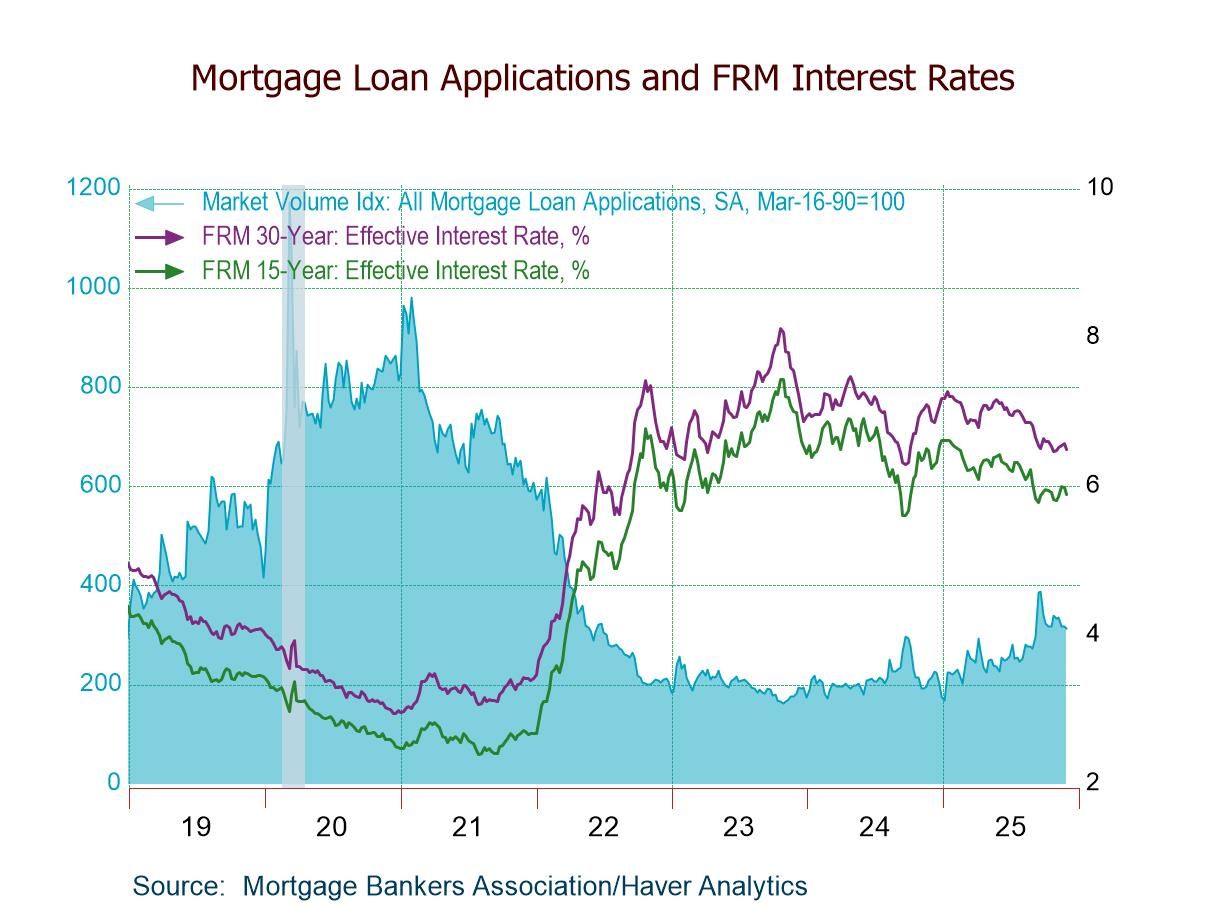 Global| Jan 06 2010
Global| Jan 06 2010U.S. ISM Nonmanufacturing Index Improves To Break-Even
by:Tom Moeller
|in:Economy in Brief
Summary
The nonmanufacturing sector has improved from its worst condition at year-end 2008 but it has yet to show much expansion. The December figure from the Institute for Supply Management (ISM) for the service & construction sectors [...]
 The
nonmanufacturing sector has improved from its worst condition at
year-end 2008 but it has yet to show much expansion. The December
figure from the Institute for Supply Management (ISM) for the service
& construction sectors improved to 50.1 last month
from below the break-even level of 50 during November. The
latest fell just short of Consensus expectations. For the
year as a whole the index reading of 46.3 was the lowest in the series'
history. Since the series' inception in 1997 there has been a 64%
correlation between the level of the composite index in the
nonmanufacturing sector and the q/q change in real GDP for
the services and the construction sectors.
The
nonmanufacturing sector has improved from its worst condition at
year-end 2008 but it has yet to show much expansion. The December
figure from the Institute for Supply Management (ISM) for the service
& construction sectors improved to 50.1 last month
from below the break-even level of 50 during November. The
latest fell just short of Consensus expectations. For the
year as a whole the index reading of 46.3 was the lowest in the series'
history. Since the series' inception in 1997 there has been a 64%
correlation between the level of the composite index in the
nonmanufacturing sector and the q/q change in real GDP for
the services and the construction sectors.
ISM surveys more than 370 purchasing managers in more than 62 industries including law firms, hospitals, government and retailers. The nonmanufacturing survey dates back to July 1997. The figures are available in Haver's USECON database.
 Amongst
the components, the business activity
index for the service sector moved back above break-even at 53.7 and
that was up sharply from one year ago. Also, the employment index
improved for the second month and was up sharply from its low in
November 2008. Since the series' inception in 1997 there has been an
80% correlation between the level of the ISM nonmanufacturing
employment index and the m/m change in payroll employment in the
service-producing plus the construction industries. Countering
these gains were declines in the new orders and the speed of vendor
deliveries indexes. This latter reading indicates that delivery speeds
quickened.
Amongst
the components, the business activity
index for the service sector moved back above break-even at 53.7 and
that was up sharply from one year ago. Also, the employment index
improved for the second month and was up sharply from its low in
November 2008. Since the series' inception in 1997 there has been an
80% correlation between the level of the ISM nonmanufacturing
employment index and the m/m change in payroll employment in the
service-producing plus the construction industries. Countering
these gains were declines in the new orders and the speed of vendor
deliveries indexes. This latter reading indicates that delivery speeds
quickened.
 Pricing
power improved for the third straight month, but
just slightly. The pricing index rose m/m to 58.7 and was up sharply
from one year ago. Since its inception ten years ago, there has been a
73% correlation between the price index and the q/q change in the GDP
services chain price index.
Pricing
power improved for the third straight month, but
just slightly. The pricing index rose m/m to 58.7 and was up sharply
from one year ago. Since its inception ten years ago, there has been a
73% correlation between the price index and the q/q change in the GDP
services chain price index.
Beginning with the January 2008 Nonmanufacturing Report On Business®, the composite index is calculated as an indicator of the overall economic condition for the non-manufacturing sector. It is a composite index based on the diffusion indices of four of the indicators (business activity, new orders, employment and supplier deliveries) with equal weights. The latest report from the ISM can be found here.
News About the Future and Economic Fluctuations from the Federal Reserve Bank of Philadelphia is available here.
| ISM Nonmanufacturing Survey | December | November | October | Dec. '08 | 2009 | 2008 | 2007 |
|---|---|---|---|---|---|---|---|
| Composite Index | 50.1 | 48.7 | 50.6 | 40.1 | 46.3 | 47.4 | 53.5 |
| Business Activity | 53.7 | 49.6 | 55.2 | 38.9 | 48.1 | 47.4 | 56.0 |
| New Orders | 52.1 | 55.1 | 55.6 | 38.9 | 48.0 | 47.0 | 54.8 |
| Employment | 44.0 | 41.6 | 41.1 | 34.5 | 40.0 | 43.8 | 52.0 |
| Supplier Deliveries | 50.5 | 48.5 | 50.5 | 48.0 | 49.0 | 51.1 | 51.1 |
| Prices Index | 58.7 | 57.8 | 53.0 | 36.1 | 49.4 | 66.0 | 63.8 |
Tom Moeller
AuthorMore in Author Profile »Prior to joining Haver Analytics in 2000, Mr. Moeller worked as the Economist at Chancellor Capital Management from 1985 to 1999. There, he developed comprehensive economic forecasts and interpreted economic data for equity and fixed income portfolio managers. Also at Chancellor, Mr. Moeller worked as an equity analyst and was responsible for researching and rating companies in the economically sensitive automobile and housing industries for investment in Chancellor’s equity portfolio. Prior to joining Chancellor, Mr. Moeller was an Economist at Citibank from 1979 to 1984. He also analyzed pricing behavior in the metals industry for the Council on Wage and Price Stability in Washington, D.C. In 1999, Mr. Moeller received the award for most accurate forecast from the Forecasters' Club of New York. From 1990 to 1992 he was President of the New York Association for Business Economists. Mr. Moeller earned an M.B.A. in Finance from Fordham University, where he graduated in 1987. He holds a Bachelor of Arts in Economics from George Washington University.






